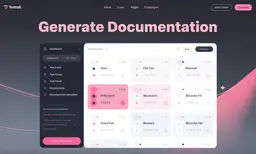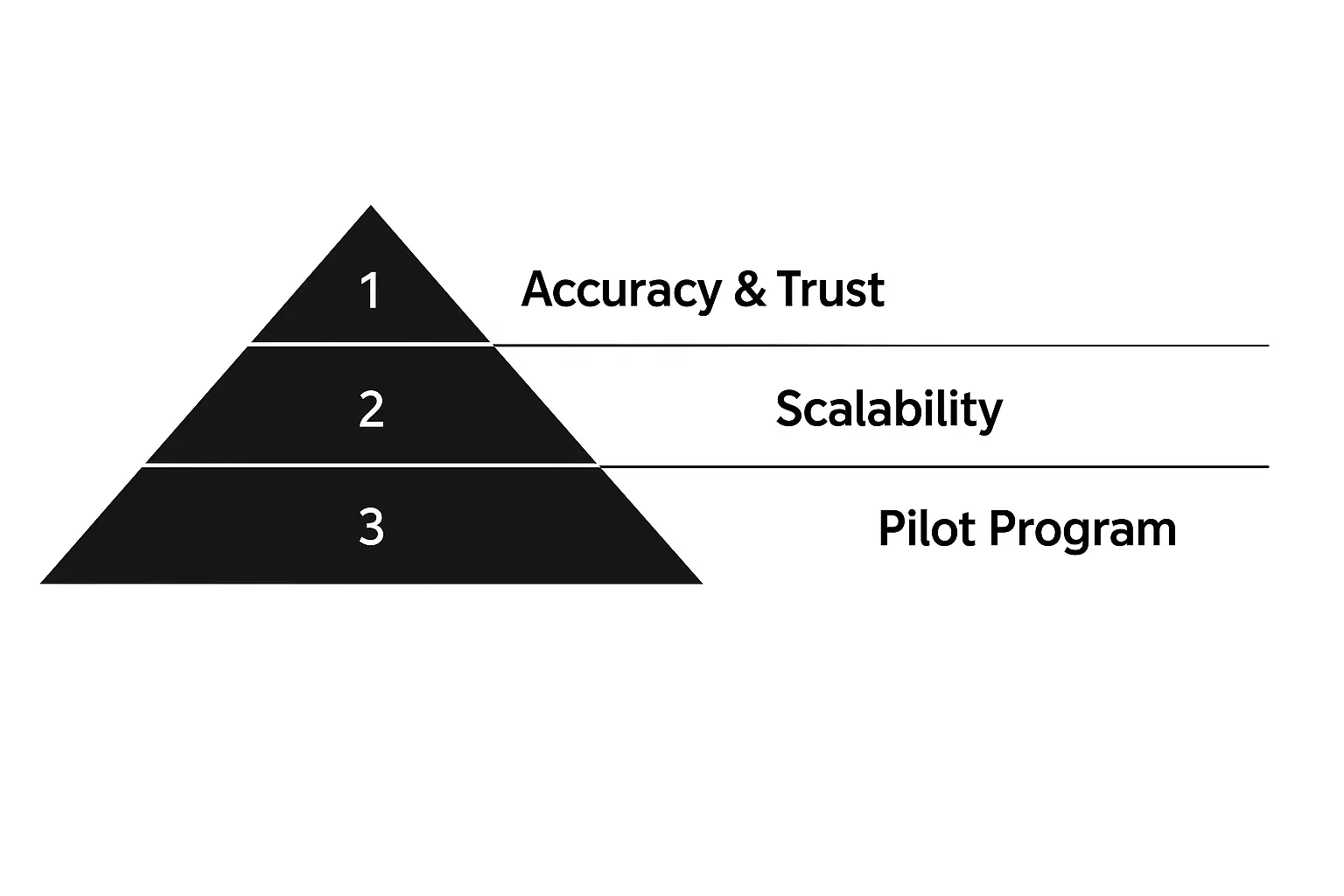
Introduction to
Software Documentation
Using Test Cases
Poor documentation causes 56% of project failures. Traditional methods often lead to outdated information and missing critical details throughout the software lifecycle.
Test case-driven documentation creates living documentation that evolves alongside the codebase, ensuring technical specifications remain accurate and reflect actual functionality.
Key Benefits
- Reduction in technical debt through aligned documentation
- Improved onboarding for new team members
- Increased confidence in software reliability
- Faster identification of regression issues
Industry leaders report up to 40% reduction in support tickets and significantly improved developer productivity when implementing this practice.
What Is Test Case-
Driven Documentation?
Definition
Industry leaders report up to 40% reduction in support tickets and significantly improved developer productivity when implementing this practice.
Usage & Implementation
Industry leaders report up to 40% reduction in support tickets and significantly improved developer productivity when implementing this practice.
Living Documentation
Stays current as tests evolve with the software, ensuring synchronization between code and documentation when changes occur.
Measurable Quality
Provides quantifiable documentation coverage through test passing rates, directly tying documentation quality to test completeness.


Benefits Over
Traditional
Documentation
Test case-driven documentation offers significant advantages over conventional approaches:
32% Accuracy Boost
Live verification ensures documentation precisely matches implementation, reducing misleading information (Forrester, 2023).
40% Onboarding Speedup
Executable examples accelerate understanding, allowing teams to integrate new members more efficiently.
32% Accuracy Boost
Live verification ensures documentation precisely matches implementation, reducing misleading information (Forrester, 2023).
Additional benefits include complete edge case coverage and 3x greater cross-team collaboration. Organizations implementing this approach consistently report improved developer experience, higher quality deliverables, and more efficient knowledge transfer.
Real-World Examples &
Industry Adoption
90% of API documentation linked to test cases since 2019 with their Documentation-as-Tests initiative.
Increased developer satisfaction by 27% and reduced onboarding time by 40%.
GitHub Copilot
Uses test-driven snippets for all API endpoints, ensuring documentation remains accurate.
Reduced support tickets by 35% while increasing developer adoption by 42%.
Stripe
Improved API error transparency with test-backed docs for all 240+ error states.
Integration success rate increased by 22% and average integration time decreased from 7 to 4.5 days.
Additional benefits include complete edge case coverage and 3x greater cross-team collaboration. Organizations implementing this approach consistently report improved developer experience, higher quality deliverables, and more efficient knowledge transfer.


Step-by-Step: Creating
Documentation via Test Cases
Define User Scenarios
Break workflows into testable steps that reflect real user interactions. Focus on common paths and edge cases.
- Identify key user journeys through interviews and analytics
- Create acceptance criteria based on business impact
Write Automated Tests
Cover main functionalities with executable tests that validate behavior and serve as living specifications.
- Use BDD frameworks like Cucumber or SpecFlow
- Structure tests hierarchically to mirror documentation needs
Generate Documentation
Transform test results into readable documentation that translates technical validations into user-friendly guidance.
- Use documentation generators like Swagger or Javadoc
- Include screenshots and examples from test runs
Update Dynamically
Keep documentation fresh by implementing CI processes that automatically regenerate docs after test runs.
- Configure CI/CD pipelines to publish updated documentation
- Track documentation coverage alongside test coverage
This process creates documentation thats accurate, comprehensive, and directly tied to working functionality—eliminating documentation drift and ensuring whats documented matches what s implemented.
Tools & Frameworks Supporting This
Approach





Tools like Allure, TestRail, and Swagger auto-generate interactive documentation from tests, while frameworks such as Cucumber, JUnit, and Pytest create living documentation that evolves with your code.
Test Management
Allure
Creates HTML reports with test execution details that serve as user guides
TestRail
Offers templates exportable as documentation with traceability
Swagger/OpenAPI
Generates API docs from test specs with endpoints and parameters
Testing Frameworks
Cucumber
Uses Gherkin syntax for scenarios that double as specifications
JUnit/TestNG
Supports annotation-based documentation for JavaDoc reports
Pytest
Offers docstring documentation and HTML report plugins
Integration Tools
CI/CD Integration
- Jenkins documentation plugins
- GitHub Actions for wiki updates
- GitLab CI for document generation
Key Benefits
- Reduces maintenance by 60%
- Ensures accuracy via verification
- Improves developer adoption
- Supports compliance requirements
These tools create an ecosystem where code changes automatically update documentation—eliminating documentation drift.
Best Practices for Effective Test Case
Documentation
Keep Tests Atomic
Keep Tests Atomic Create self-explanatory test cases focused on single behaviors. Each test should verify one specific functionality aspect.
Link to Features
Connect tests to user stories and requirements. Establish clear traceability to ensure comprehensive test coverage.
Regular Review
Schedule quarterly reviews to update or remove obsolete tests. Establish versioning to track documentation changes.
Cross-Team Collaboration
Involve developers, QA engineers, and documentation specialists to improve quality and accuracy.
Consistent implementation creates a virtuous cycle that improves documentation quality over time. Clear, linked, maintained, and collaboratively created documentation becomes valuable for the entire organization.
Effective Test Case Design &
Documentation Techniques
Boundary Value Analysis
Test at the edges and just beyond input limits to identify common defects that occur at boundaries. For example, if valid values are 1-100, test with 0, 1, 100, and 101. This technique is particularly effective for numerical inputs, date ranges, and character limits where edge cases frequently cause failures.
Equivalence Partitioning
Divide input data into valid and invalid equivalence classes to reduce redundant test cases while maintaining coverage. This technique assumes that if one value in a partition works correctly, other values in the same partition will behave similarly. This significantly reduces test case count while preserving testing effectiveness and system confidence.
Decision Tables
Document complex business rules and conditions in tabular format to ensure all logical combinations are tested. Decision tables excel at handling multiple input combinations and are especially valuable for financial systems, approval workflows, and complex validation rules where numerous conditions interact. They provide a systematic approach to ensure comprehensive test coverage.
Behavior-Driven Development (BDD)
Structure tests in Given-When-Then format to improve readability and align with business requirements. This approach bridges the communication gap between technical and non-technical stakeholders by using natural language specifications. BDD promotes collaboration between developers, testers, and business analysts while creating living documentation that remains valuable throughout the product lifecycle.
Traceability Matrices
Map test cases to requirements to ensure complete coverage and identify gaps in testing. Traceability matrices provide bidirectional links between requirements, test cases, and defects, making it easier to assess the impact of requirement changes. They serve as valuable audit tools during compliance reviews and help project managers track testing progress against business objectives.
Template-Based Documentation
Use consistent templates with pre-conditions, steps, expected results, and actual outcomes for clarity. Well-designed templates enforce standardization across the testing team, reduce onboarding time for new testers, and improve test case maintainability. They should include fields for test case ID, version, priority, execution status, and related defects to support comprehensive test management.
Conclusion & Recommendations

Our systematic approach to test case design and documentation offers key benefits:
Benefits
- Increased Test Coverage: Comprehensive coverage with fewer test cases
- Improved Communication: Better understanding across all stakeholders
- Reduced Maintenance: Documentation remains relevant as requirements evolve
Implementation Steps
- Conduct test documentation audit
- Establish standardized templates
- Train QA teams on test design techniques
- Implement regular review cycles
